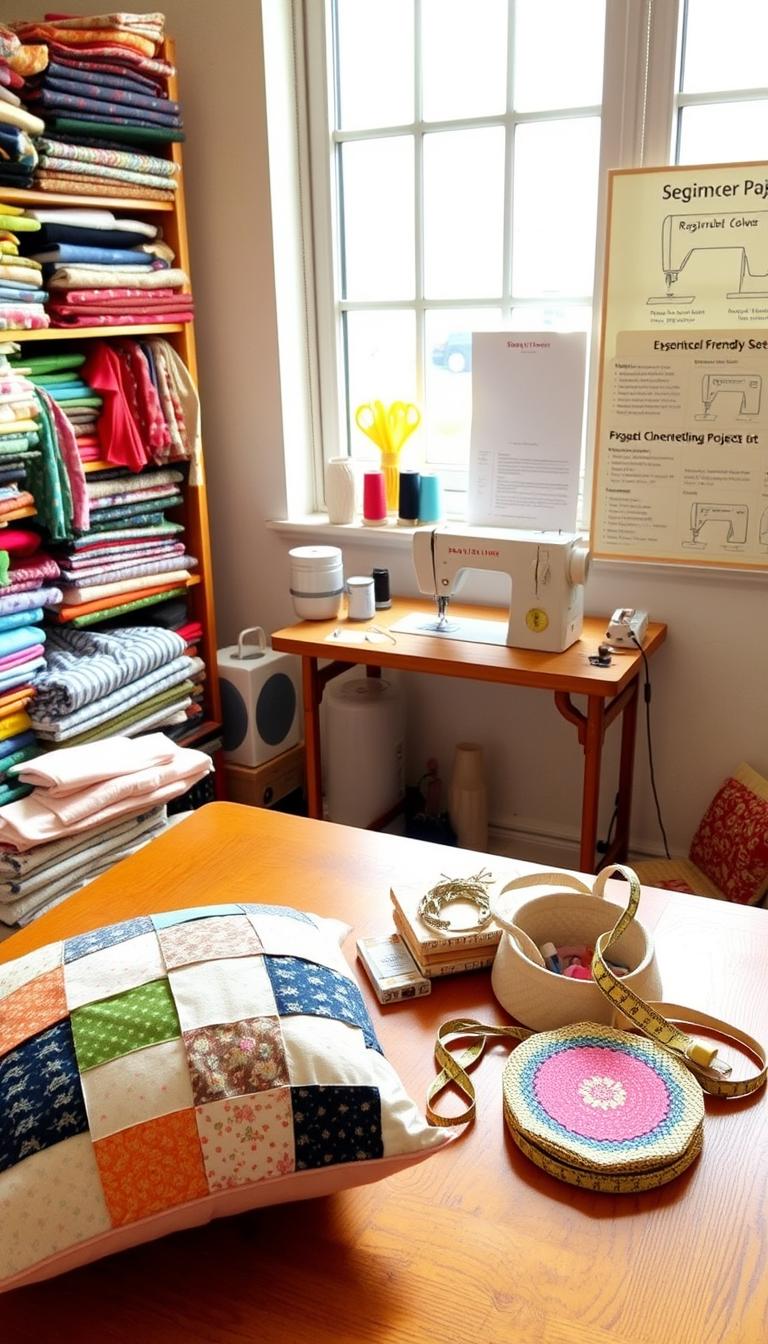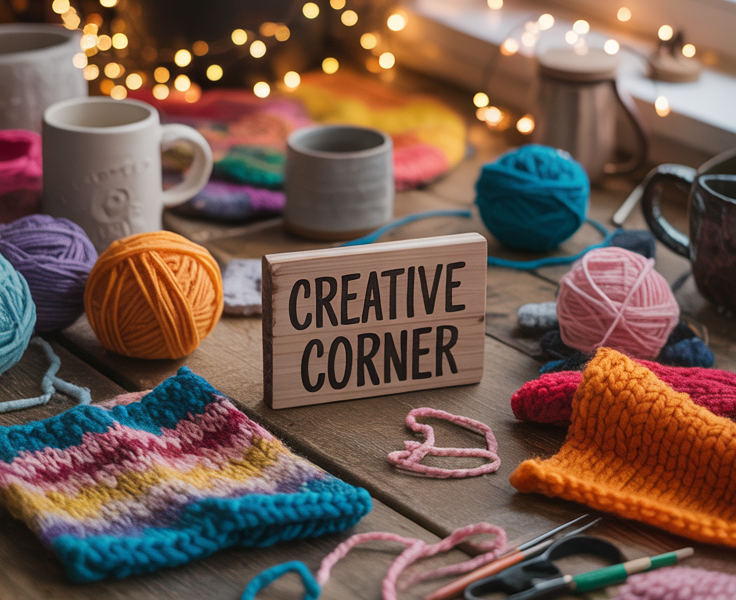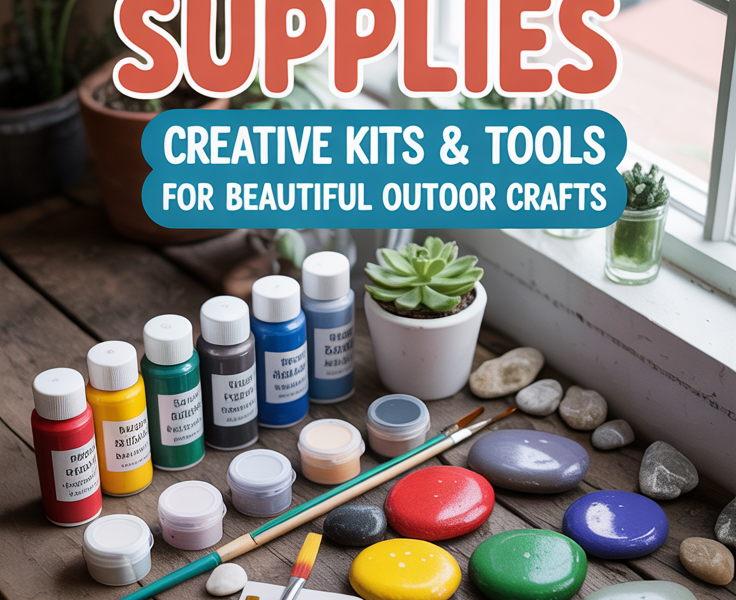Over 50 free beginner-friendly sewing patterns exist online—and most take less than an afternoon to complete! Whether you’re holding a needle for the first time or dusting off your machine, these ideas turn “I can’t” into “I made this!” faster than you’d think.
This post contains affiliate links. If you purchase through these links, I may earn a small commission at no extra cost to you. Learn more here.
Let’s get real: starting a new craft can feel overwhelming. But here’s the secret—simple projects build skills without frustration. SewingPatternSecrets.com curates foolproof patterns that skip the confusion. Think cozy pillow covers, roomy tote bags, and even no-zip aprons. No advanced techniques required.
Here’s the best part: every project includes crystal-clear instructions. You’ll learn how to thread machines, choose fabrics, and fix common mistakes. By the end, you’ll have handmade items that actually look store-bought (but way cooler because you made them).
✂️ Want even more beginner-friendly sewing patterns? Unlock hundreds at Sewing Pattern Secrets today!
Key Takeaways
- Beginner-friendly patterns boost confidence quickly
- Trusted resources like SewingPatternSecrets.com simplify learning
- Step-by-step guides ensure success from stitch one
- Projects range from practical bags to personalized decor
- Basic machine skills are covered upfront
Introduction to Sewing for Beginners
Picture this: transforming flat fabric into something useful and uniquely yours with just a needle and thread. Sewing blends practicality with creativity—you get to fix that torn shirt and design a statement tote bag in the same afternoon. Best part? You don’t need to be Martha Stewart to nail it.
New to the craft? Start with free sewing patterns designed for first-timers. These blueprints walk you through every cut and stitch, like GPS for fabric. “A good pattern eliminates guesswork,” says a SewingPatternSecrets.com instructor. “Follow the lines, and you’ll surprise yourself.”
Here’s the deal: your first project shouldn’t require a PhD in threading machines. Think drawstring pouches or no-frills totes—they teach straight seams and basic shapes. Master these, and suddenly quilts or aprons feel achievable.
Pro tip: grab a beginner-friendly machine (more on that later) and cotton fabric. These materials forgive mistakes and let you focus on building muscle memory. Before you know it, you’ll crank out gifts that look store-bought but carry your personal flair.
Remember: every expert once sewed a crooked line. Your journey starts with one straight stitch.
Getting Started: Tools, Machines, and Fabric
Let’s talk gear—because even Picasso needed brushes. The right tools don’t just make sewing easier; they turn “Ugh, why?!” moments into “Aha!” victories. Start smart, and you’ll avoid the #1 beginner mistake: fighting your supplies instead of creating.
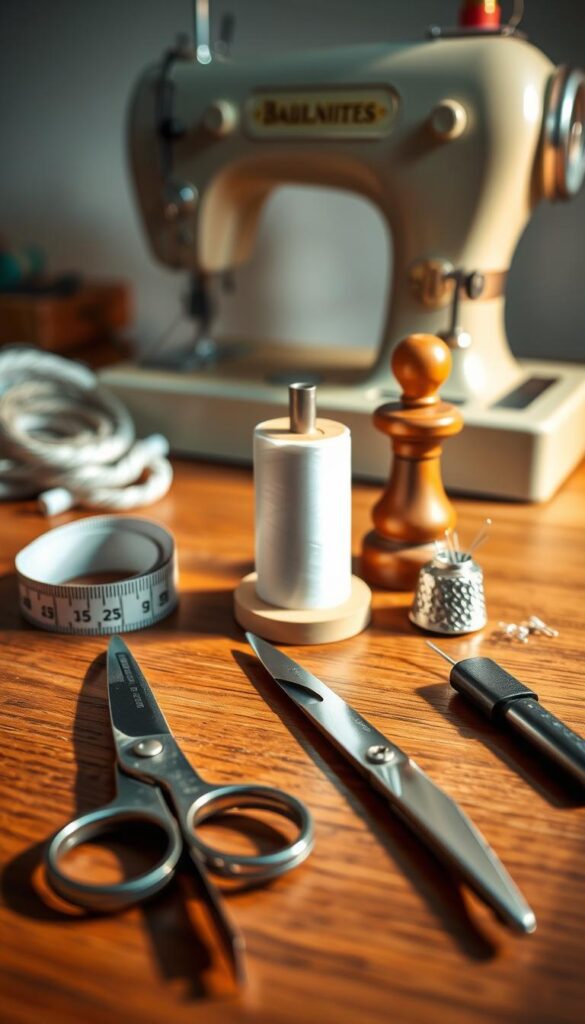
Essential Tools for New Sewists
Your starter kit needs just five basics: sharp fabric scissors (never use them on paper!), a seam ripper (your secret undo button), straight pins with colorful heads, a flexible measuring tape, and washable fabric markers. These are the bare-bones heroes that handle 90% of simple projects.
✨ Ready to fast-track your sewing skills? Get instant access to expert-designed patterns here!
Why splurge on fat quarters? These 18×22” fabric cuts are a great way to experiment without wasting money. Mix and match colors for pillow covers or zipper pouches—perfect for testing skills before tackling bigger yardage.
LUXJA Large 2 Layers Sewing Organizer Bag with 5 Detachable Dividers, Sewing Storage Bag for Sewing Supplies, Polka Dots
Choosing the Right Sewing Machine and Fabric
Your first machine should have three things: a straight stitch, zigzag option, and easy threading. Skip the fancy embroidery features—mechanical models from brands like Brother or Singer offer reliability under $200. Pro tip: Check Facebook Marketplace for lightly used machines with manuals included.
Stick to 100% cotton fabric initially—it’s stable, affordable, and won’t slip like satin. Pre-wash everything to prevent shrinkage disasters later. And remember: YouTube tutorials are free mentors. One SewingPatternSecrets.com teacher puts it best: “Watch the thread tension video twice—your future self will thank you.”
Start with a great way to build confidence: sew straight lines on scrap fabric before jumping into projects. Master the basics, and those fat quarters will transform into gifts faster than you can say “bobbin.”
Brother CS7000X Computerized Sewing and Quilting Machine, 70 Built-in Stitches, LCD Display, Wide Table, 10 Included Feet, White
Sewing Pattern Secrets: How Patterns Can Guide Your Projects
Think of patterns as your project’s GPS—they tell you exactly where to cut, fold, and stitch. A well-designed pattern from Sewing Pattern Secrets turns confusing fabric piles into polished creations. It’s like having a patient teacher whispering, “Fold here, pin there, and breathe—you’ve got this.”

Decoding the Blueprint
Pattern instructions work best when you treat them like a recipe. Start with the materials list—wrong fabric choices can derail even simple table runner projects. Next, study the diagrams. Those dotted lines and arrows? They show fold directions and seam allowances that photos alone can’t capture.
Here’s why measurements matter: a tote bag pattern specifies exact handle lengths for comfortable shoulder carry. Miss by an inch, and you’ll get arm-pinching straps. Always lay fabric as the guide shows—this prevents wasting material or cutting pieces too small.
Pro tip from sewingpatternsecrets.com: “Highlight key steps with markers before starting.” This trick helps avoid skipped instructions when making table runners or other multi-step items. Patterns also flag common pitfalls, like forgetting to backstitch at a sewing machine’s start/stop points.
- Symbols = universal sewing shorthand (circles mark buttonholes)
- Layout diagrams prevent fabric waste
- Precise cutting = professional-looking results
Mastering patterns lets you crank out tote bags in half the time. Soon, you’ll modify designs confidently—maybe add pockets to that table runner or adjust sewing machine settings for thicker fabrics. It all starts with trusting the roadmap.
10 Easy Sewing Projects for Absolute Beginners
Ready to turn fabric into functional treasures? These handpicked creations build skills while delivering wow-factor results. From cozy home accents to carry-everywhere bags, each project comes with foolproof patterns that hold your hand through every snip and stitch.
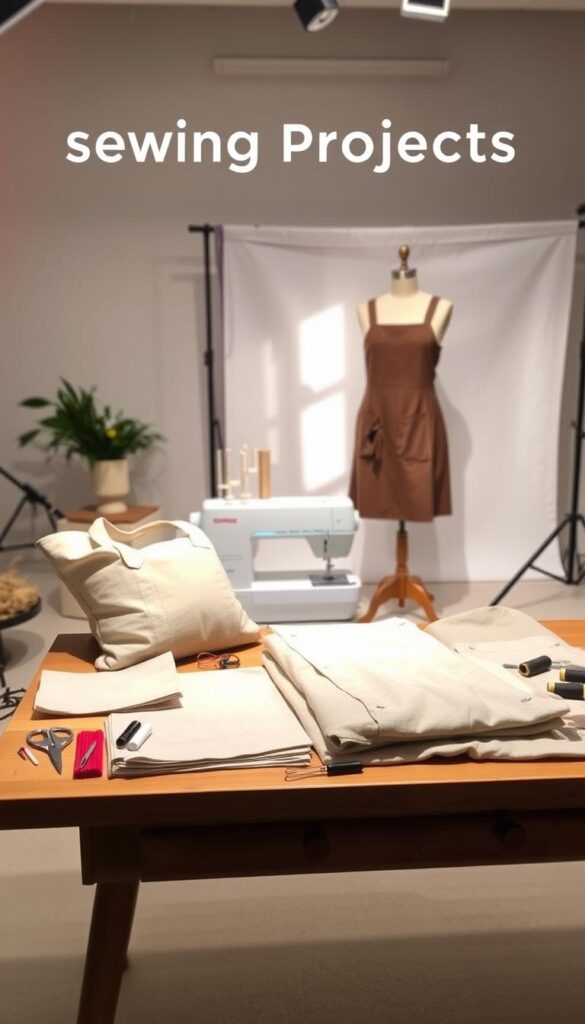
Project Inspiration: Bags, Pillows, and More
Start with forgiving cotton for envelope pillow covers—they teach straight seams and hidden closures. Move to quilting-weight fabric for reversible totes that survive grocery runs. Pro tip: Use bold prints to hide minor imperfections while learning.
Drawstring pouches work magic with scrap material. Follow the pattern’s marked fold lines to create crisp corners. “Skipping steps causes 80% of beginner errors,” notes a SewingPatternSecrets.com designer. Stick to the guide, and your first zippered pouch will look pro-made.
Step-by-Step Breakdown of Each Project
Every tutorial walks you through:
- Pre-washing fabric to prevent shrinkage surprises
- Cutting pieces with ½” seam allowances
- Securing stitches at start/end points
🧵 Learning is easier with the right patterns. Find your next beginner project inside Sewing Pattern Secrets.
Table runners make perfect practice for straight lines. Choose medium-weight linen—it doesn’t stretch like knits. When your bobbin acts up (it happens!), revisit the pattern’s troubleshooting section. Most issues fix faster than threading a needle.
“Treat each step like a building block—master one before jumping to the next.”
Celebrate small wins: a puckered seam here or uneven hem there just shows progress. Before long, you’ll customize patterns like a boss—adding pockets to aprons or mixing fabrics for statement pillows. The magic? Starting simple builds unshakable confidence.
Creative Bag Projects: Tote Bags, Pouches, and Drawstring Bags
Bags aren’t just carriers—they’re blank canvases with handles. Stitch a tote that fits your laptop, a chapstick holder for your keys, or a drawstring gym bag that screams “you.” These projects turn practice into tangible wins while gifting you functional items you’ll actually use daily.
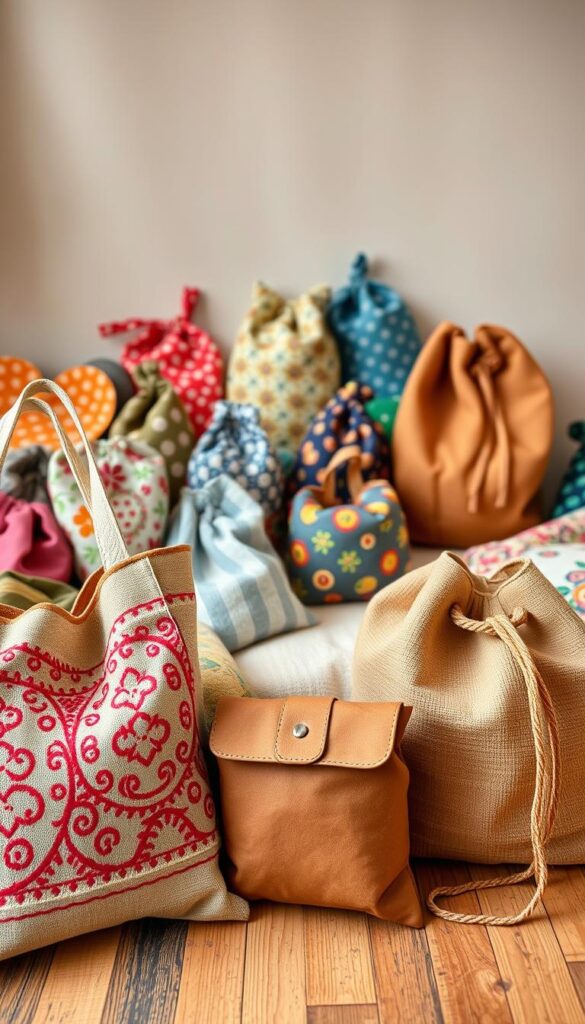
Why bags? They’re the ultimate mix of creativity and utility. A basic tutorial for a zippered pouch teaches straight seams, lining techniques, and hardware installation—all foundational skills. Plus, finished pieces make thoughtful gifts. Imagine handing your cousin a custom beach tote with fabric matching her favorite sundress.
Top resources like SewingPatternSecrets.com break down each step visually. Their beginner-friendly video guides show exactly how to:
- Cut fabric pieces without fraying edges
- Attach sturdy straps that won’t snap
- Hide seams for polished interiors
Store-bought bags can’t compete with personalized details. Add inner pockets to that drawstring sack for yoga mat storage. Use waterproof lining for poolside totes. One maker on YouTube even stitched glow-in-the-dark thread into her gym bag’s seams—talk about flair!
“Bags let beginners experiment without pressure. Mess up a pocket? Call it ‘rustic charm’ and keep going.”
Fabric matters: medium-weight cotton or canvas holds structure best. Avoid slippery materials until you’ve nailed straight stitching. Pro tip: Use contrasting thread colors to highlight your progress—those early wobbly lines will transform into crisp seams faster than you think.
Home Decor Inspirations: Pillows, Table Runners, and Covers
Your couch is begging for personality. With fabric and basic stitches, you can craft decor that whispers “this is so me” without shouting “I tried too hard.” Home accents like pillow covers and table runners let beginners practice precision while creating pieces that actually get used daily.

Tips for Accurate Cutting and Finishing
Sharp fabric scissors are non-negotiable—dull blades create frayed edges. Always measure twice using a clear quilting ruler. Pro tip: mark cutting lines with chalk instead of pens. It wipes off if you mess up.
🌟 Don’t waste hours searching for free patterns that disappoint. Grab premium sewing patterns in minutes!
Press seams open as you go. This simple step makes finished items look store-bought. For table runners, use patterns with ½” seam allowances—they hide minor alignment slips. And here’s a game-changer: starch fabric lightly before cutting. It stiffens material for cleaner cuts.
Selecting Materials to Enhance Your Space
Mix textures for visual interest: pair linen pillow covers with velvet throw blankets. Stick to 2-3 complementary colors per room. Beginners thrive with pre-cut fabric bundles—they’re curated to match perfectly.
Check out free patterns for home decor to spark ideas without cost. One SewingPatternSecrets.com designer advises: “Use geometric prints on rectangular items like table runners—they disguise uneven stitching lines beautifully.”
Remember: your first pillow cover doesn’t need to be perfect. Crooked seams add character. But following patterns closely teaches you the way to achieve polished results faster. Soon, you’ll tweak designs confidently—maybe add tassels to curtain ties or quilted details to placemats.
Simple Clothing Projects for New Sewists
Who says your first garment has to look homemade? With the right patterns, you can stitch closet-worthy pieces that friends will swear you bought boutique. Start with pre-loved tees or thrifted fabrics—they’re forgiving canvases for learning seams without pressure.
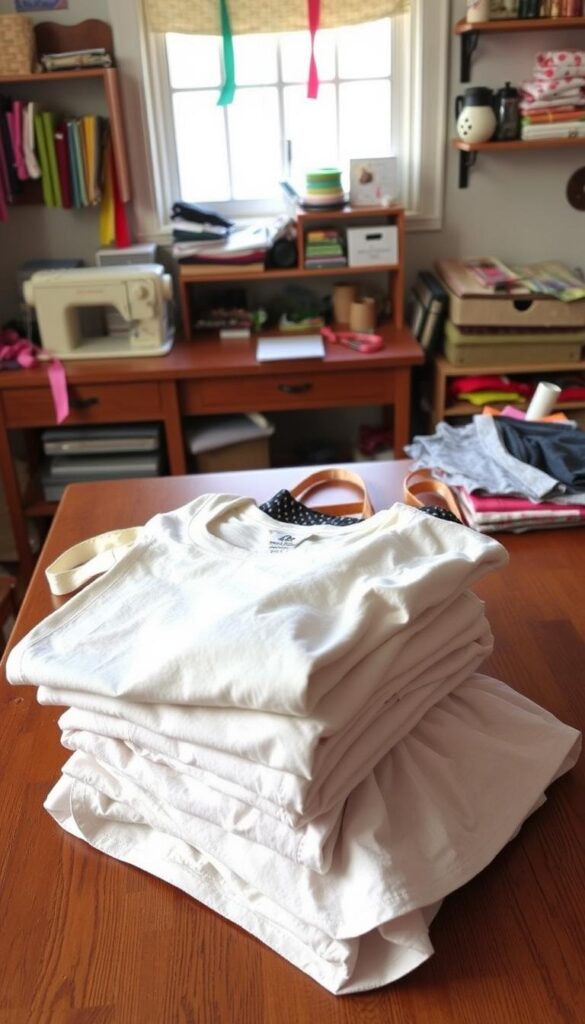
Circle skirts steal the show here. They require just two measurements (waist + length) and zero zippers. Use elastic waistbands for adjustable comfort, or upcycle a bedsheet into breezy summer wear. One SewingPatternSecrets.com member raves: “I made three skirts in one weekend—now my whole book club wants matching ones!”
Not into skirts? Try these instant-gratification ideas:
- Transform oversized shirts into cropped tops with clean hem lines
- Add lace trim to basic tank straps for boho flair
- Turn jeans into distressed shorts using fabric chalk and sharp scissors
These creations double as heartfelt gifts—imagine gifting a niece her first handmade apron or tailoring a partner’s too-long dress shirt. Pro tip: Use quilting cotton for structured items like aprons, and jersey knits for stretchy headbands or lounge pants.
📚 Turn your sewing dreams into reality—without guesswork! Start with Sewing Pattern Secrets’ step-by-step guides.
Stuck on sizing? Modify patterns by tracing onto wrapping paper first. Adjust lengths before cutting fabric, and always keep seam rippers handy. Remember: clothing projects thrive on experimentation. That uneven hem? Call it “asymmetric design” and rock it confidently.
Transforming Fabric Scraps into Unique Creations
Those fabric scraps piling up? They’re treasure in disguise. Repurposing leftovers cuts waste while sparking creativity—think of it as a crafty puzzle where every piece has potential. Bonus: you’ll save cash and keep materials out of landfills.
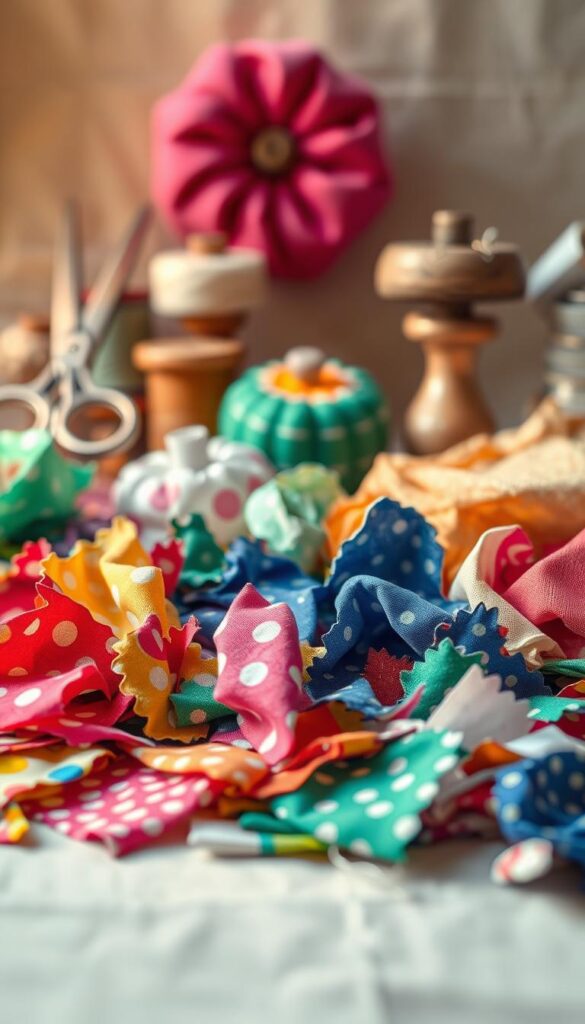
Start with patchwork pillow covers—stitch mismatched squares into bold designs. Smaller scraps become fabric-covered notebooks or quirky bookmarks. For bags, sew scrap strips into drawstring pouches or use coordinating prints for tote accents. Patchwork projects turn chaos into cohesive art.
Precision matters. Use a rotary cutter and quilting ruler for clean edges. When piecing scraps, press seams flat to avoid bulk. Pro tip: arrange pieces on interfacing before sewing—it stabilizes fragile fabrics.
Mix textures like linen and cotton for tactile interest. Pair bold florals with solids for contrast. “Scraps are design gold,” says a SewingPatternSecrets.com expert. “They force you to think outside the fabric bolt.”
These ideas prove sustainability doesn’t mean sacrificing style. Your scrap stash becomes a launchpad for one-of-a-kind decor and accessories—all while keeping your craft space clutter-free.
Step-by-Step Sewing Tutorials and Video Guides
Ever stared at a sewing pattern feeling completely lost? Video tutorials are the flashlight in that darkness. Platforms like YouTube host thousands of free visual guides that show stitches in real time—no more guessing what “right sides together” actually means.
Why Your Screen Just Became Your Best Teacher
Visual learners rejoice: watching someone sew a fat quarters project eliminates confusion. You’ll see exactly how to fold fabric corners for crisp edges or position scraps for patchwork. Unlike written patterns, videos let you:
- Pause and rewind tricky techniques
- Zoom in on hand positions for perfect stitching
- Hear audio explanations of common mistakes
Projects like reversible tote bags or quilted pot holders become simpler when you can watch each step. One SewingPatternSecrets.com instructor notes: “Students who follow video guides master skills 40% faster—their eyes catch details words can’t convey.”
Use tutorials to transform intimidating tasks into manageable bites. Learning buttonholes? Watch the demo three times—first for overview, second for hand placement, third for machine settings. This approach builds muscle memory without frustration.
💡 Need fresh ideas for your next sewing project? Browse the massive collection at Sewing Pattern Secrets!
Platforms like Skillshare even offer slow-motion replays. Perfect for mastering curves on fat quarters projects or aligning scraps in geometric patterns. Pro tip: save videos to a “Sewing 101” playlist for quick access during projects.
“Videos turn ‘How does that work?!’ into ‘Oh, that’s how you thread a bobbin!’ instantly.”
As your skills grow, challenge yourself with advanced tutorials. Try a zippered pouch using leftover scraps or design matching coasters from fat quarters. Each video-watching session adds another tool to your creative belt.
Budget-Friendly and Sustainable Sewing Projects
Stitching your way to savings doesn’t mean sacrificing style—or the planet. Transform forgotten clothes into trendy pouches or adjust a thrifted dress to fit your exact size. Sustainability meets creativity when you view old materials as free supplies waiting for reinvention.

Start with what you own: that oversized band tee becomes a drawstring pouch in 30 minutes. Curtain remnants? Perfect for breezy summer dresses with adjustable straps. Thrift stores overflow with linen sheets and tablecloths—ideal for zero-cost fabric stashes.
Smart sourcing tips:
- Check fabric stores’ remnant bins for $2/yard deals
- Use pillowcases as pre-sewn dress bodices
- Upcycle jeans into crossbody bags using existing pockets
Invest in quality scissors and a seam ripper—they’ll handle countless projects. A SewingPatternSecrets.com designer notes: “Good tools pay for themselves when you remake 10+ items from one $5 thrifted blazer.”
Need versatility? Draft pouch patterns that scale to any size—phone sleeves, lunch bags, laundry organizers. For dresses, choose wrap styles that adapt to body changes. Bonus: these projects teach fitting skills while keeping closets eco-friendly.
Remember: every upcycled creation keeps textiles out of landfills. Your needle becomes a wand that turns “trash” into treasure—one stitch at a time.
Tips to Enhance Your Sewing Skills and Techniques
Sharp needles and fresh thread can’t fix everything—but smart habits can. Elevate your stitching game with these battle-tested tricks that smooth out common speed bumps. Whether you’re wrestling with wobbly seams or tangled bobbins, small adjustments deliver big results.
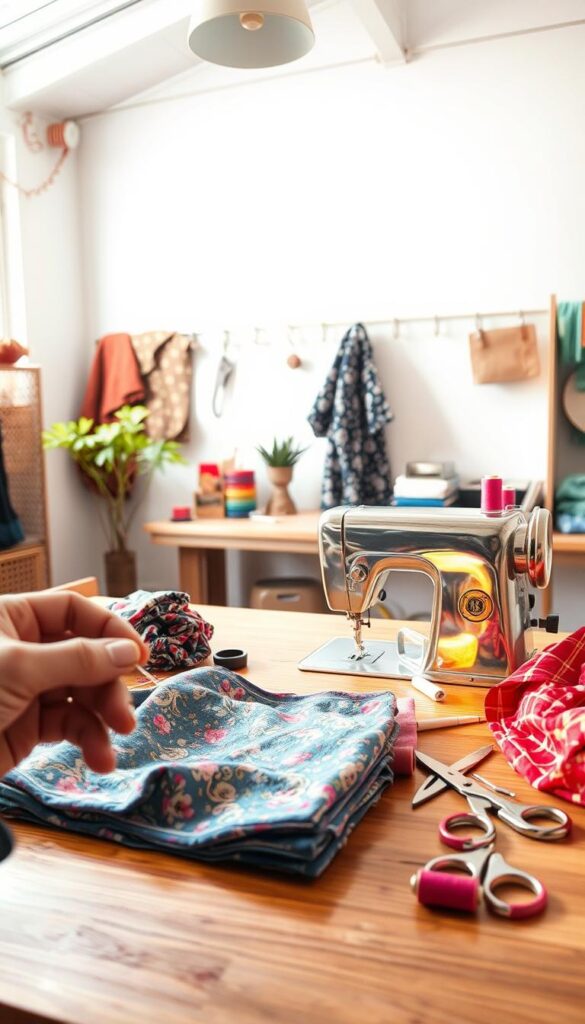
Avoiding Common Beginner Mistakes
Fabric alignment is everything. Always match right sides together before pinning—those little arrows on patterns exist for a reason. For table runner projects, use quilting rulers to keep stripes perfectly straight. One misaligned piece can throw off an entire design.
🎯 Absolute beginners love these easy-to-follow patterns! See what’s waiting for you inside Sewing Pattern Secrets.
Machine tension troubles? Test stitches on scrap fabric first. Top thread should nestle neatly between layers without puckering. Storage hacks matter too: keep threads in zippered bags to prevent dust buildup, and store frequently used tools in labeled bins near your workspace.
- Press seams open with an iron—it’s the secret to professional finishes
- Clip loose threads immediately to avoid tangled disasters
- Store fabric folded on shelves—not stuffed in drawers—to prevent creases
When working with multiple pieces, label them with washable markers. A SewingPatternSecrets.com instructor notes: “Numbered fabric sections prevent ‘Which side is up?!’ panic during assembly.” This trick works wonders for complex runners or patchwork projects.
Lastly, embrace the seam ripper. Even pros undo stitches—it’s how you learn precision. With smart storage solutions and careful piece alignment, you’ll spend less time fixing errors and more time creating showstoppers.
Quick Projects: What You Can Sew in Minutes
Got 15 minutes? Your sewing machine just became a time machine. Quick projects prove you don’t need hours to create something useful—or Instagram-worthy. Think fabric coasters, scrunchies, or mini zipper cases that organize your desk chaos.
Start with fabrics like pre-cut fat quarters or old T-shirts. These materials skip the measuring step—just fold, stitch, and boom: instant headband or makeup pouch. As SewingPatternSecrets.com notes: “Speed-sewing isn’t about rushing. It’s smart prep meeting simple designs.”
Clear instructions turn lightning-fast ideas into reality. For example:
- Fold a 12” square into a envelope-style phone case (4 seams max)
- Stitch straight lines on fleece scraps for pet bandanas
- Upcycle jeans pockets into keychain holders
Set up your workspace for success: keep a “quick kit” with threaded needles, pre-wound bobbins, and scissors. This lets you dive into projects during TV ad breaks or while coffee brews.
These bite-sized creations build momentum. Each finished piece—no matter how small—proves your skills grow faster than thread unravels. Next time someone says “make me something,” you’ll have a handmade case ready before they finish their sentence.
Organizing Your Sewing Space for Efficiency
Ever lost your scissors mid-project? A chaotic workspace kills creativity faster than a broken needle. Smart organization turns your sewing zone into a productivity playground—where every tool has a home and inspiration flows freely.
Start by sorting items into three piles: daily essentials (scissors, pins), occasional tools (buttonhole attachments), and rarely used supplies. Store daily items within arm’s reach using wall-mounted racks or magnetic strips. Label everything—clear jars for buttons or thread spools prevent “What’s in here?!” moments.
Set up your machine station first. Keep bobbins, needles, and measuring tapes in a divided tray beside it. This pre-arranged system saves minutes per project—no more digging through drawers mid-stitch. Pro tip: Use a pegboard for vertical storage. It’s like Tetris for sewing gear.
A tidy space isn’t just pretty—it sharpens focus. Studies show clutter increases stress hormones by 15%. Clear surfaces mean fewer distractions when mastering tricky techniques. “Organization isn’t about perfection,” notes a DIY blog. “It’s about creating flow.”
15-Minute Tune-Up Checklist:
- Wipe down surfaces with microfiber cloth
- Return tools to labeled homes
- Wind 3 extra bobbins for common thread colors
- Sort fabric scraps by size in clear bins
Set aside 10 minutes after each session to reset your space. Future you will thank present you—especially when starting that midnight inspiration rush.
Exploring Free Patterns and Online Resources
The internet’s sewing community just became your fabric playground. Thousands of free patterns await—from breezy wrap skirts to structured totes—all downloadable with one click. These resources eliminate guesswork while letting you experiment risk-free.
Top sites like SewingPatternSecrets.com offer curated collections sorted by difficulty. Want clothes that fit like a dream? Search their “Adjustable Wrap Dresses” category. Prefer home decor? Filter for table runners or curtain panels. Every pattern includes fabric recommendations—often cotton for its durability and ease of handling.
Cotton remains the MVP for beginners. It holds creases well, doesn’t slip, and comes in every print imaginable. One pattern designer notes: “A basic wrap skirt in quilting cotton teaches curved seams without frustration.”
🪡 Master the basics with confidence. Get access to the best beginner sewing patterns now!
Join Facebook groups like “Sew & Tell Beginners” for real-time advice. Members share their latest makes—think linen aprons or upcycled clothes—and troubleshoot common issues. Bonus: many groups host free pattern swaps monthly.
“Free patterns are gateway drugs to creativity—you’ll soon be modifying designs like a pro.”
Ready to dive in? Bookmark AllFreeSewing for daily inspiration. Their search filters let you find projects by fabric type, skill level, and even season. Suddenly, that wrap dress pattern feels less intimidating—and more like your next triumph.
Community Support and Inspiration in Sewing
Sewing becomes a team sport when you tap into online communities. Imagine having 24/7 access to cheerleaders who’ve sewn through every mistake imaginable. These spaces turn isolation into collaboration—perfect for beginners needing quick answers or fresh ideas.
Your Digital Sewing Squad
Platforms like Reddit’s r/sewing and Facebook’s Sewing for Beginners group buzz with activity. Members post photos of their latest covers for couches or beds, asking for feedback on stitch lengths or fabric choices. One user recently shared how the group helped her transform uneven gifts into professional-looking pot holders.
Instagram’s @sewcanshe account thrives on tagged project shares. Use their hashtag #SewingSquad when posting your first free sewing pattern creation. You’ll often get pattern designers commenting with tweaks or alternative techniques—like how to adjust covers for odd-shaped pillows.
- Facebook: “Sew Much Fun Beginners” (65k members)
- Reddit: r/freepatterns (daily free sewing pattern shares)
- Discord: Stitch & Bitch (live troubleshooting chats)
Communities frequently swap gifts ideas—think personalized pencil cases or upcycled tote bags. Many designers drop exclusive free sewing pattern links in these groups too. As one SewingPatternSecrets.com admin notes: “We’ve seen members go from confused to confident just by asking ‘How do I fix this?’ with a photo.”
Tagging your makes does more than show off skills. It builds connections that fuel motivation. Next time you finish a free sewing pattern project, share it boldly. You might inspire someone else to thread their first needle.
Conclusion
Your needle’s been threaded—now let’s talk momentum. From picking your first scissors to stitching polished tote bags, you’ve got everything needed to thrive. Remember: every master once fumbled their bobbin.
Sewing projects beginners love succeed because they focus on progress, not perfection. Those early pillow covers? They taught you straight seams. The wobbly-hemmed apron? It proved you could follow patterns. Each project builds skills that turn “maybe” into “heck yes.”
Here’s the truth no one tells you: starter wins matter most. Beginner sewing isn’t about flawless finishes—it’s discovering how fabric becomes function. Revisit those free tutorials when doubt creeps in. Bookmark SewingPatternSecrets.com’s video library for midnight inspiration.
Share your makes boldly. Post that lopsided pouch on Reddit—someone’s battling the same seam. Swap fabric scraps in Facebook groups. Every “first try” photo inspires another sewing projects beginner to thread their machine.
Ready for your next chapter? Grab those fat quarters. Adjust that pattern. Your journey from “What’s a presser foot?” to “I designed this!” starts with one stitch. And hey—we’re all cheering you on.
🎀 Don’t just sew — create something beautiful. Explore Sewing Pattern Secrets and start today!
